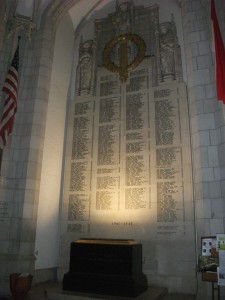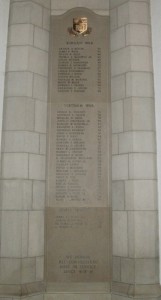WW II Memorial
The memorial in the rotunda of Anabel Taylor Hall, dedicated in 1953, records over 500 casualties suffered by Cornell in WWII. In 1993, tablets were added to honor Cornellians killed in Korea and Vietnam and in 2003, the memorial was rededicated, adding Cornellians who died in the Persian Gulf and other conflicts. [15][8]
Details about WWII casualties is available online from the National Archives.
Korea, Vietnam and other conflicts since WWII
In 1993, tablets were added to honor Cornellians who served in Korea and Vietnam.
In 2003, the memorial was rededicated, adding Cornellians who died in the Persian Gulf and other conflicts.
Korean War casualty information is available from The National Archives.
Korean War:
Arthur Bell Butler ’30
An infantry major, Butler was killed in action in Korea in August 1950. He was awarded the Distinguished Service Cross and the Silver Star. The Butler Memorial Trophy is awarded to a member of the varsity squad voted by his teammates to have done the most for Cornell rowing during the year. The trophy was put up by members of Cornell’s 1930 champion crew in memory of their crewmate, Arthur Bell Butler ’30, who rowed in the second seat. This award has been presented each year since 1956. [36]
James P. Weir ‘34
Private Weir was a veteran of World War II. During the Korean War he was a member of the 32nd Infantry Regiment, 7th Infantry Division. He was Killed in Action while fighting the enemy in South Korea on September 23, 1950. Private Weir was awarded the Purple Heart, the Combat Infantryman’s Badge, the Korean Service Medal, the United Nations Service Medal, the National Defense Service Medal, the Korean Presidential Unit Citation, the Republic of Korea War Service Medal, the American Campaign Medal, and the World War II Victory Medal. [35]
Grant R. Ellis ‘44
Thomas A. Baldwin Jr. ‘46
Thomas Abbott Baldwin Jr. was from Cook County, Illinois. He attended New Trier Township High school. His father is an architect with the Crane company. He joined Cornell as a member of the marine training unit, and he received his degree in architectural engineering in 1946. He was called to active duty in October 1950 and served as a 1st LT in the 1st Marine, 1st Engineering Battalion. He was killed in action on June 19, 1951, at the age of 26. He was awarded the Purple Heart, National Defense Service Medal, Korean Service Medal, Republic of Korea Presidential Unit Citation, United Nations Service Medal, and Republic of Korea War Service Medal. [6][7]
Oscar Seltzer ‘49
Thousands of American soldiers were sent overseas to fight in Korea, including Oscar Seltzer. As a pre-med student at Cornell University, Sergeant Oscar Seltzer served as a medical aid man within the 223rd Infantry Regiment, 40th Infantry Division. Fighting under difficult conditions in North Korea, it was Sergeant Seltzer’s responsibility to administer aid to the wounded soldiers around him. On April 13, 1952, Sergeant Seltzer was attempting to save the lives of wounded soldiers while under enemy fire. With his attention focused on a fellow soldier, Sergeant Seltzer was hit and critically wounded himself. Yet, in an act of incredible heroism and sacrifice, Sergeant Seltzer was still providing life-saving aid and medical care to his fellow soldiers until he died from his own wounds. Seltzer received numerous awards and medals for his service, including the Purple Heart, the United Nations Service Medal, the Korean Service Medal, and more. For his great act of valor, Sergeant Oscar Seltzer was also posthumously awarded the prestigious Silver Star, the Army’s third highest combat award, which was presented to his family. [34]
Alfred J. Honsinger ‘49
Robert B. Andrews ‘51
Theodore B. Freeman ‘27
Laurie Fitzgibbon ‘51
Second Lieutenant Laurie Fitzgibbon, USMC, born May 24, 1927, graduated with a BS from the College of Agriculture in 1951. He was from Tarrytown, NY. He was a member of the Sigma Nu fraternity. He was killed in action October 27, 1952, in Korea. He was with Co. C, 7th Reg., 1st Battalion, 1st Marine Division. He was awarded the Purple Heart. He is buried at Sleepy Hollow Cemetery, Sleepy Hollow, New York. His parents are Mr. and Mrs. Laurie Fitzgibbon. Commendations: Combat Action Ribbon, Korean Service Medal, National Defense Service Medal, Republic of Korea Presidential Citation, Republic of Korea War Service Medal, United Nations Service Medal, Marine Corps Presidential Unit Citation, Marine Corps Good Conduct Medal, Marine Corps Expeditionary Medal [31][32][33]
Edward J. Rock ‘50
Ulrich Myller ‘53
Charles M. Marino ‘52
Bruce M. Mack ‘49
Edward L. Feakes ‘49
Harrison C. Jacobs ‘51
Harold P. Turner ‘40
Vietnam War:
George R. Varney ‘51
Geoffrey Emmons Green ’62
1LT Geoffrey Emmons Green graduated with a A.B. degree in Asian studies from the College of Arts and Sciences in 1962. After graduating from Cornell, he was commissioned as an infantry officer in the U.S. Marine Corps. Arriving in Vietnam he was serving as the Executive Officer of Company B, 1st Battalion, 7th Marines, 3d MARDIV (Rein) FMF. During Operation Piranha near Phu Qui Mui village on the Batangan Peninsula, the Marines discovered a complex of caves and tunnels. Explosive charges were set and detonated; 1stLt Green with eight Marines went underground to search the caves and tunnels. Overcome by the lack of oxygen the men were rescued from the tunnel complex; however 1stLt Green was not able to recover and died. [46]
Michael McPherson Deuel ’59
Michael McPherson Deuel was born in Berlin, Germany on May 13, 1937. His father Wallace Deuel worked as a foreign correspondent for the Chicago Daily News before the start of World War II. His family later moved to Washington, DC, where he played high school football and was president of his class. Deuel was one of 25 National Scholarship winners to enroll at Cornell in 1955. While at Cornell he was a brother in the Sigma Phi fraternity and played varsity lacrosse. In 1959, he graduated from the College of Arts and Sciences. Deuel was then commissioned as a second lieutenant in the U.S. Marine Corps, and eventually shipped out to Southeast Asia. He returned home safely in 1962 and was honorably discharged from the Marines.
In 1964, Deuel became a refugee relief advisor for the U.S. Agency for International Development (USAID) and was stationed in Pakse, Laos. He died in a helicopter crash while giving sightseeing tours to civilians – At least that would be the story the world would believe for decades to come. In truth Michael McPherson Deuel was there to participate in what history has since defined as “the secret war” against the communists. In 1997 his records were declassified, and Michael’s name was finally revealed in the Book Of Honor showing that Deuel had been working for the CIA. According to the CIA’s website Michael McPherson Deuel, an Operations Officer in the Directorate of Plans (now the Directorate of Operations), was killed in a helicopter crash in the jungles of Southeast Asia while participating in covert operations in 1965. There is a great writeup on his service available on CIA.gov Michael McPherson Deuel, Captain USMCR, received a star on the CIA Memorial Wall in 1974 and is buried in Arlington National Cemetery. [47][48]
John C. Strickler Jr. ‘57
Ronald W. Ringwall ‘63
Kenneth A. Keith ‘65
Nicholas Krimont ‘63
John S. Roederer ‘61
David C. Hall ‘64
Robert G. Porea ‘67
Gordon S. Perisho ‘61
Douglas D. Crowe ‘61
Fred W. Carpenter ‘57
Robert L. Crosby ‘65
Richard H. Boise ‘68
R. Creighton Williams ‘67
Albert H. Gates Jr. ‘66
Stanley Lewis ‘60
David C. Mossner ‘68
William L. Sullivan ‘65
Richard A. Aaron ‘64
David N. Fox ‘67
Robert J. Kiser ‘71
Ken H. Taketa ‘71
Henry J Repeta ‘55
Joseph Gambino Jr. ‘69
Patrick A. Deck Jr. ‘69
Roger H. Coye ‘52
John J Lawendowski ‘52
Iraq:
Richard J. Gannon II ‘95
George A Wood ‘93
Other Hostilities:
James B. Deane Jr. ‘54
Joseph Brender ‘55
Benjamin S. Park Jr. ‘57
R. Bruce Hart ‘84
Anabel Taylor Hall is also a memorial to Myron C Taylor’s wife Anabel Stuart Taylor built in 1953. Constructed 23 years after its companion building, Myron Taylor Hall, Anabel Taylor Hall closes off the northern side of the Myron Taylor courtyard. It was opened as an Interfaith Center. It also includes Anabel Taylor Chapel, a location in the Hall for worship services, weddings, and musical events. Quoting from excerpts of Myron Taylor’s Dedication Speech, Anabel Taylor Hall, October 26, 1952:
“…Here is one place where all religions may repair for worship, and for that inward reflection upon God and immortality which precede and follow sincere worship, however voiced. Here a lonely soul may meditate and pray by himself; here, groups may gather; here, a numerous congregation may join in songs of praise. If rules be necessary for the governance of this sanctuary, let them be such as promote tolerance and a quiet respect for religious ideas and customs not our own. Here, majority opinion need not rule, to the confusion of the individuals; neither shall a minority stir tumult in the hearts of others.”


